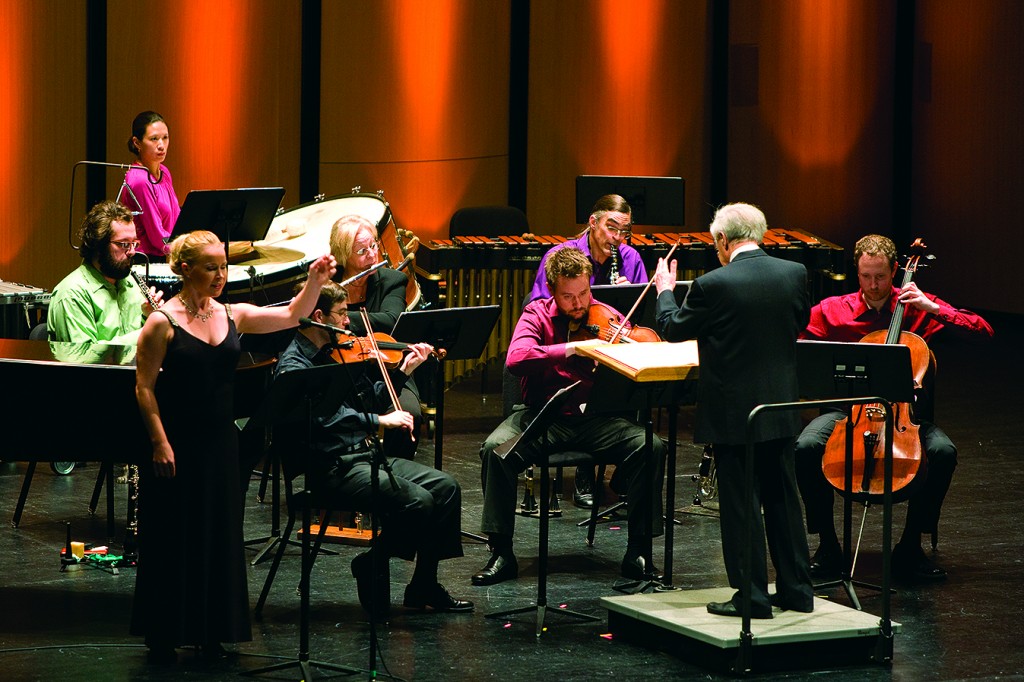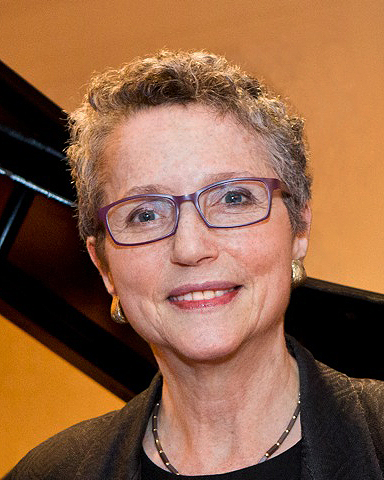The Chicago Symphony Orchestra’s MusicNOW series, which marks its 20th season in 2017-18, has proven to be an important force in many ways, perhaps most notably as a catalyst for Chicago’s extraordinary transformation as a center of contemporary classical music.
This metamorphosis was underscored last year with the first-ever Ear Taxi Festival, a showcase of new music by 88 composers, with a staggering 54 world premieres. The six-day event, which concluded with a MusicNOW concert, grabbed international attention and demonstrated how far the city’s contemporary music scene has evolved in just a few decades.
Key to the growth of MusicNOW, as well as Chicago’s evolution as a new music hub, has been role of the CSO’s composers-in-residence program, an initiative launched in 1987 under Georg Solti. To celebrate its legacy, MusicNOW will present a retrospective program Oct. 2 with works by all seven former composers-in-residence: Mason Bates, Anna Clyne, John Corigliano, Osvaldo Golijov, Shulamit Ran, Augusta Read Thomas and Mark-Anthony Turnage. The concert, titled MusicNOW @ 20 Years and curated by Samuel Adams and Elizabeth Ogonek, the CSO’s current composers-in-residence, will begin at 7 p.m. Monday at the Harris Theater for Music and Dance, home to the series since the 2004-05 season.

Pierre Boulez leads a MusicNOW concert in March 2009. | ©Todd Rosenberg Photography 2009
MusicNOW concerts feature CSO musicians in groups typically ranging in size from duos to small ensembles of 15 or so members. Cliff Colnot, DePaul University’s director of orchestral activities, has served as principal conductor of MusicNOW since its inception. Over the series’ 20 years, scores of works have been programmed by composers ranging from venerable figures like Elliott Carter and György Kurtág to rising talents like Christopher Trapani and Kyle Vegter. Each program is followed by beer, pizza and conversation.
“If you want to go hear new, contemporary classical art music played beautifully, this is the place,” said Thomas, who held the composer-in-residence post from 1997 through 2006 and played a pivotal role in establishment of MusicNOW.
In 1964, Ralph Shapey, an acclaimed member of the University of Chicago’s composition faculty, founded the Contemporary Chamber Players (later renamed Contempo), which dominated Chicago’s new music scene for a few decades. While the CSO had always performed some contemporary music, its importance was reconfirmed with the introduction of the composer-in-residence program. John Corigliano, famed for works such as the opera The Ghosts of Versailles, held the first residency, followed by Shulamit Ran, another longtime member of the U. of C. faculty.
During Ran’s tenure from 1990 through 1997, she pushed for the idea of an ongoing new-music series; in November 1992, she laid the foundation with occasional offerings such as a two-concert mini-series whimsically titled Oh Them Rats Is Mean in My Kitchen! after a work by Stephen Hartke. “Would that all new music events were as intelligently planned or as persuasively performed,” wrote Chicago Tribune critic John von Rhein.
One obstacle to the series had been the lack of a suitably sized space, a problem alleviated in 1997 with the $114 million renovation of Symphony Center, which included the addition of the chamber-sized Buntrock Hall. Thomas, who took over as composer-in-residence in that year, submitted an outline to orchestra management that served as a blueprint for what eventually would become MusicNOW. “The proposal I put forward was this kind of vibrant, diverse, kaleidoscopic series, so that if we did four concerts a year, we would be doing 16 composers a year,” she said. “And you add that up over a decade or more, and it really gets quite interesting.”

Mason Bates appears via video at the MusicNOW performance of his The Rise of Exotic Computing. | © Todd Rosenberg Photography 2014
Then music-director Daniel Barenboim and Pierre Boulez, principal guest conductor from 1995 through 2006, both enthusiastically embraced the idea and subsequently led concerts in the series. In December 1998, MusicNOW was launched with the Arditti String Quartet and pianist Ursula Oppens in works by Carter and two other American composers, Charles Ives and Conlon Nancarrow. The sold-out concert drew a crowd of 300.
Perhaps most critical to the series’ long-range prospects was a $1 million, five-year challenge grant in 2001 from CSO trustee Joan Harris and her husband, Irving. (They were also major benefactors of the Harris Theater for Music and Dance, which was named for them.) “She was incredibly fabulous,” Thomas said. “She was so open-minded and positive and got it right away. She totally understood it.” A year later, CSO trustee Cynthia Sargent and her sister, governing member Sally Hands, endowed the composer-in-residence post for a 20-year term, a bequest that also had a direct impact on MusicNOW.
A key facet of Thomas’ original vision was the idea that there would be “no house style.” Instead, the concerts would feature works by the composers-in-residence, as well as pieces by friends and colleagues — both recent works and new creations commissioned by the CSO. “You can see the distinctive voices, the distinctive passions, the distinctive interests of each composer-in-residence who comes in the fold,” Ran said. “So there is a wonderful variety of perspectives that come to fore.”
An early MusicNOW highlight came in December 2002 with Boulez’s Anthèmes 2 (1997), a work for solo violin and live electronics, featuring violinist Yuan-Qing Yu (now CSO assistant concertmaster) as soloist. “The audience, surrounded by eight loudspeakers, heard Yu’s live violin sounds transformed into exploding electronic popcorn, her trills and arabesques turned into ornate contrapuntal riffs,” wrote von Rhein in his review. “At times she played a duet with herself in ghostly harmonics. The effect was aurally exhilarating, never predictable. I wouldn’t hesitate to call Anthèmes 2 the last important violin work to be written in the late 20th century.”

Shulamit Ran
Although the Los Angeles Philharmonic’s New Music Group began in 1981, performing in what became known as the Green Umbrella series in 1987-88, MusicNOW has been nonetheless a pioneering initiative among the nation’s traditional Big Five Orchestras. The New York Philharmonic, for example, did not begin its Contact! new-music series until 2009, with the arrival of Alan Gilbert as music director. “I’d like to think that in Chicago at that time we were doing some really innovative work,” said Matías Tarnopolsky, who served as the CSO’s senior director of artistic planning from 1999 through 2006, and is now executive and artistic director of Cal Performances at the University of California-Berkeley.
As the city’s best known classical-music institution, the CSO and its commitment to new music have been a huge boon to the local scene. “This is a major thing to have a series that emanates from the Chicago Symphony and is taking place regularly downtown, now at the Harris Theater, so this is the flagship,” Ran said. “This is the place where people come from all parts of city and suburbs to experience new music.”
MusicNOW ensures that contemporary composition has a consistently strong presence among the CSO’s offerings and reminds listeners that classical music is not a museum artifact but a living, ever-changing art form. “When Beethoven was writing, not every piece of his was loved but people gave it a chance,” said Cynthia Yeh, the CSO’s principal percussionist and frequent MusicNOW participant. “Things still need to get written and played now to see what lasts the test of time, and this is part of that process.”
At the same time, said CSO bass Robert Kassinger, another MusicNOW regular, the series provides a boost to CSO musicians themselves by giving them a chance to play in a chamber-music setting and engage with the music of their time. “I think playing new music is good for musicians in general,” he said. “It keeps our ears fresh and provides some pretty incredible challenges to our technical skills. I think it’s enhanced the orchestra quite a bit.”
Yeh would like to see MusicNOW offer more concerts in non-traditional venues, which could help draw younger patrons who feel more comfortable in less formal spaces. Le Poisson Rouge, a 250-seat nightclub in New York City, for instance, has hosted concerts by classical stars like violinist Hilary Hahn. Regardless of where the concerts are performed, Kassinger hopes the current format continues. “I think the design of the program is really conducive to keeping things fresh going forward, and I’m not sure that it needs to be adjusted in any way,” he said.
Whatever direction MusicNOW takes in its next decades, Tarnopolsky and others are confident it has already had a huge impact both in Chicago and well beyond: “Celebrating the new and working with some phenomenal composers, we created together something that was innovative, powerful and we now see, enduring.”
TOP: Cliff Colnot leads CSO musicians and guest performers in a tribute to Pierre Boulez at a MusicNOW concert in April. | ©Todd Rosenberg Photography 2017